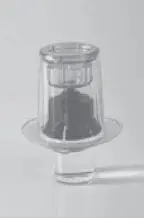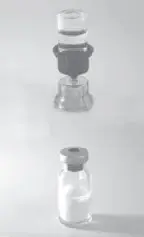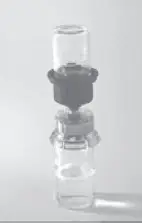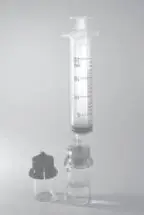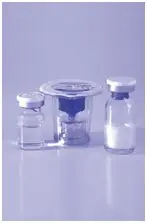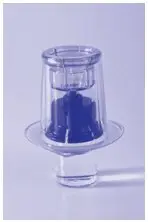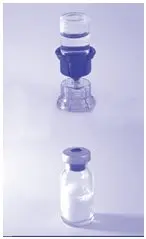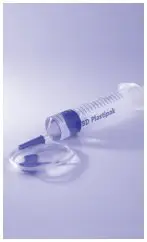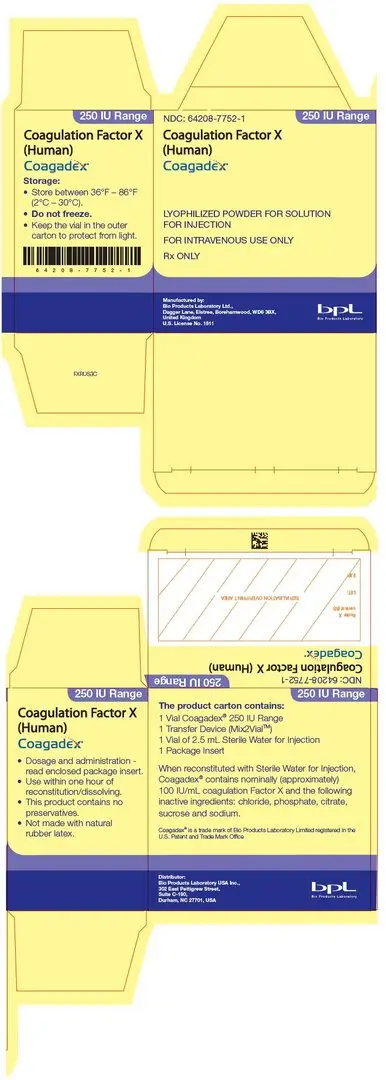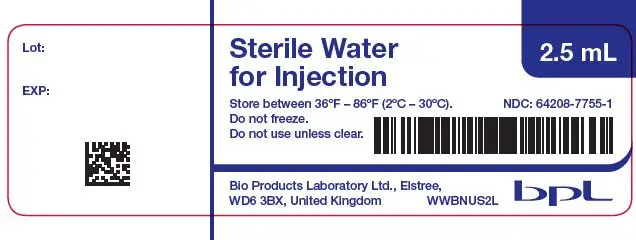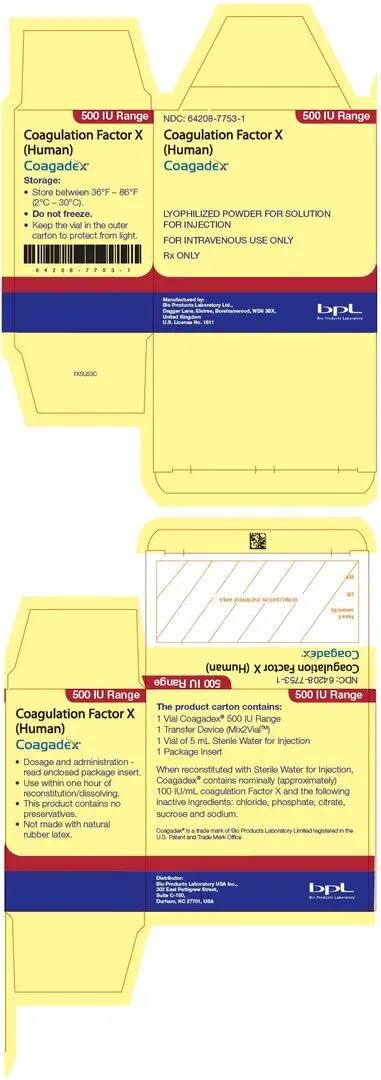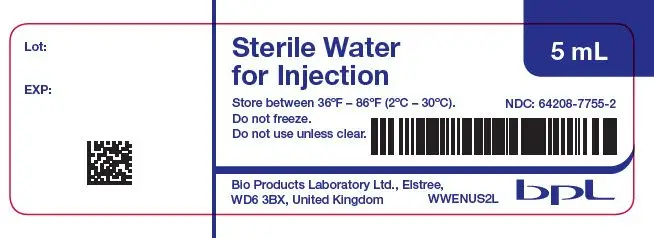Drug Detail:Coagadex (Coagulation factor x [ koe-ag-ue-lay-tion-fak-tor-x- ])
Drug Class: Miscellaneous coagulation modifiers
Highlights of Prescribing Information
COAGADEX® (Coagulation Factor X (Human))
Lyophilized Powder for Solution for Intravenous Injection
Initial U.S. Approval: [2015]
Recent Major Changes
| INDICATIONS AND USAGE (1) | 4/2023 |
| DOSAGE AND ADMINISTRATION (2, 2.1, 2.3) | 4/2023 |
Indications and Usage for Coagadex
COAGADEX, Coagulation Factor X (Human), is a plasma-derived human blood coagulation factor indicated in adults and children with hereditary Factor X deficiency for:
- Routine prophylaxis to reduce the frequency of bleeding episodes (1)
- On-demand treatment and control of bleeding episodes (1)
- Perioperative management of bleeding in patients with mild, moderate and severe hereditary Factor X deficiency (1)
Coagadex Dosage and Administration
For intravenous use only after reconstitution.
- Each vial of COAGADEX contains the labeled amount of Factor X in international units (IU) (2)
- The dosage and duration of treatment depend on the severity of the Factor X deficiency, the location and extent of the bleeding and the patient's clinical condition (2.1)
- For prophylaxis of bleeding episodes (2.1):
| Age | Initial dose | Further management |
|---|---|---|
| Children: Less than 12 years of age | 40 IU/kg twice weekly | Monitor trough blood levels of Factor X targeting ≥5 IU/dL and adjust dosage to clinical response and trough levels. Do not exceed a peak level of 120 IU/dL. |
| Adults and adolescents: 12 years of age or older | 25 IU/kg twice weekly |
- For treatment of bleeding episodes (2.1):
| Age | Initial dose | Further management |
|---|---|---|
| Children: Less than 12 years of age | 30 IU/kg | Infuse at first sign of bleeding. Repeat at intervals of 24 hours until the bleed stops. |
| Adults and adolescents: 12 years of age or older | 25 IU/kg |
- For perioperative management (2.1):
| Age | Initial dose | Further management |
|---|---|---|
| Children: Less than 12 years of age | Use a factor of 0.6 to calculate the required dose | Pre-surgery: raise plasma Factor X levels to 70-90 IU/dL. Post-surgery: maintain plasma Factor X levels at ≥50 IU/dL until the patient is no longer at risk of bleeding due to surgery. |
| Dose (IU) = body weight (kg) × desired factor X rise† (IU/dL or % of normal) × 0.6 | ||
| Adults and adolescents: 12 years of age or older | Use a factor of 0.5 to calculate the required dose | |
| Dose (IU) = body weight (kg) × desired factor X rise‡ (IU/dL or % of normal) × 0.5 | ||
Dosage Forms and Strengths
COAGADEX is available as a lyophilized powder for reconstitution in single-dose vials containing nominally (approximately) 250 IU or 500 IU of Factor X activity. When reconstituted using the Sterile Water for Injection supplied with the kit, the final concentration is approximately 100 IU/mL (3).
Contraindications
Do not use in patients who have had life-threatening hypersensitivity reactions to COAGADEX (4).
Warnings and Precautions
- Hypersensitivity reactions, including anaphylaxis, are possible. Should symptoms occur, discontinue COAGADEX and administer appropriate treatment (5.1).
- Development of neutralizing antibodies (inhibitors) may occur. If expected plasma Factor X activity levels are not attained, or if bleeding is not controlled with an appropriate dose, perform an assay that measures Factor X inhibitor concentration (5.2).
- COAGADEX is made from human blood and therefore carries a risk of transmitting infectious agents, e.g. viruses, the variant Creutzfeldt-Jakob disease (vCJD) agent and, theoretically, the Creutzfeldt-Jakob disease (CJD) agent (5.4).
Adverse Reactions/Side Effects
The most common adverse drug reactions (frequency ≥ 5% of subjects) observed in clinical trials were infusion site erythema, infusion site pain, fatigue and back pain (6).
To report SUSPECTED ADVERSE REACTIONS, contact BPL USA Inc., at 1-844-427-5872 or [email protected] or FDA at 1-800-FDA-1088 or www.fda.gov/medwatch.
See 17 for PATIENT COUNSELING INFORMATION and FDA-approved patient labeling.
Revised: 4/2023
Full Prescribing Information
1. Indications and Usage for Coagadex
COAGADEX, Coagulation Factor X (Human), is a plasma-derived human blood coagulation Factor indicated in adults and children with hereditary Factor X deficiency for:
- Routine prophylaxis to reduce the frequency of bleeding episodes
- On-demand treatment and control of bleeding episodes
- Perioperative management of bleeding in patients with mild, moderate, and severe hereditary Factor X deficiency
2. Coagadex Dosage and Administration
For intravenous use after reconstitution only
2.1 Dose
- Dose and duration of the treatment depend on the severity of the Factor X deficiency, location and extent of the bleeding, the patient's age (<12 years or >12 years) and the patient's clinical condition.
- Base the dose and frequency on the individual clinical response. Do not administer more than 60 IU/kg daily.
- Each vial of COAGADEX is labeled with the actual Factor X potency/content in International Units (IU).
| Age | Initial dose | Further management |
|---|---|---|
| Children: Less than 12 years of age | 40 IU/kg twice weekly | Due to inter-and intra-patient variability, it is recommended that trough blood levels of Factor X should be monitored at intervals, especially in the first weeks of therapy or after dosages changes. Adjust dosage regimen to clinical response and trough levels of Factor X of at least 5 IU/dL. Do not exceed a peak level of 120 IU/dL. [For more detailed calculations of dose, see Detailed Dose Calculation (2.1)]. |
| Adults and adolescents: 12 years of age or older | 25 IU/kg twice weekly |
| Age | Initial dose | Further management |
|---|---|---|
| Children: Less than 12 years of age | 30 IU/kg | Infuse COAGADEX when the first sign of bleeding occurs [see Clinical Trial Experience (6.1)]. Repeat at intervals of 24 hours until the bleed stops. [For more detailed calculations of dose, see Detailed Dose Calculation (2.1)]. |
| Adults and adolescents: 12 years of age or older | 25 IU/kg |
| Age | Initial dose | Further management |
|---|---|---|
| Children: Less than 12 years of age | Use a factor of 0.6 to calculate the required dose | Measure post-infusion plasma Factor X levels for each patient before and after surgery to ensure that hemostatic levels are obtained and maintained. Pre-surgery: calculate the dose of COAGADEX to raise plasma Factor X levels to 70-90 IU/dL Post-surgery: Repeat dose as necessary to maintain plasma Factor X levels at a minimum of 50 IU/dL until the patient is no longer at risk of bleeding due to surgery |
| Dose (IU) = body weight (kg) × desired factor X rise† (IU/dL or % of normal) × 0.6 | ||
| Adults and adolescents: 12 years of age or older | Use a factor of 0.5 to calculate the required dose | |
| Dose (IU) = body weight (kg) × desired factor X rise‡ (IU/dL or % of normal) × 0.5 | ||
2.2 Preparation and Reconstitution
- Always work on a clean surface and wash your hands before performing the following procedures.
- To reconstitute, use the diluent (Sterile Water for Injection) and transfer device (Mix2Vial) provided in the COAGADEX carton.
- To administer, you will also need a syringe and suitable needle (not provided in the COAGADEX carton).
- Bring the vials of COAGADEX and the Sterile Water for Injection to room temperature before mixing.
- The reconstitution is performed as follows:
|
| Step 1
|
|
| Step 3
|
|
| Step 4
|
|
| Step 5
|
|
| Step 6
|
|
| Step 8
|
2.3 Administration
For intravenous administration only
- If the dose requires more than one vial of COAGADEX:
- Reconstitute each vial (steps 1 to 5) using a new Mix2Vial for each vial
- Draw up all of the solution into a single syringe (steps 6 to 8)
- Visually inspect the final solution for particulate matter and discoloration prior to administration. Do not use if particulate matter or discoloration is observed
- Attach a suitable needle to the syringe
- Administer by intravenous infusion at a rate of 10 mL/min, but no more than 20 mL/min
3. Dosage Forms and Strengths
COAGADEX is available as a white or off-white lyophilized powder for reconstitution in single-dose vials containing nominally (approximately) 250 IU or 500 IU of Factor X activity. The exact potency/content is listed on the vial label. When reconstituted using the Sterile Water for Injection supplied with the kit, the final concentration is approximately 100 IU/mL.
Factor X activity in COAGADEX is defined in IU and determined using an in vitro chromogenic assay and a Factor X concentrate reference standard calibrated against the current World Health Organization (WHO) International Standard for Blood Coagulation Factors II and X, Concentrate.
4. Contraindications
COAGADEX is contraindicated in patients who have had life-threatening hypersensitivity reactions to COAGADEX [see Description (11)].
5. Warnings and Precautions
5.1 Hypersensitivity Reactions
Allergic type hypersensitivity reactions, including anaphylaxis, are possible. Early signs of hypersensitivity reactions including angioedema, infusion site inflammation (e.g. burning, stinging, erythema), chills, cough, dizziness, fever, flushing, generalized urticaria, headache, hives, hypotension, lethargy, musculoskeletal pains, nausea, pruritus, rash, restlessness, tachycardia, tightness of the chest, tingling, vomiting, wheezing. If hypersensitivity symptoms occur, discontinue use of the product immediately and administer appropriate emergency treatment.
COAGADEX contains traces of human proteins other than Factor X.
5.2 Neutralizing Antibodies
The formation of neutralizing antibodies (inhibitors) to Factor X may occur. Monitor all patients treated with COAGADEX for the development of inhibitors by appropriate clinical observations and laboratory tests. If expected Factor X activity levels are not attained, or if bleeding is not controlled with an expected dose, perform an assay that measures Factor X inhibitor concentration.
5.3 Transmissible Infectious Agents
As COAGADEX is made from human blood, it may carry a risk of transmitting infectious agents, e.g. viruses, the variant Creutzfeldt-Jakob disease (vCJD) agent and, theoretically, the Creutzfeldt-Jakob disease (CJD) agent. There is also the possibility that unknown infectious agents may be present in the product. The risk that the product will transmit viruses has been reduced by screening plasma donors for prior exposure to certain viruses, by testing for the presence of certain current virus infections, and by inactivating and removing certain viruses during manufacture. Despite these measures, this product may still potentially transmit diseases.
All infections suspected by a physician possibly to have been transmitted by this product should be reported by the physician or other healthcare providers to BPL USA Inc. at 1-844-427-5872 or [email protected].
5.4 Monitoring and Laboratory Tests
- Monitor plasma Factor X activity by performing a validated test (e.g. one-stage clotting assay), to confirm that adequate Factor X levels have been achieved and maintained [see Dosage and Administration (2)].
- Monitor for the development of Factor X inhibitors. Perform a Nijmegen-Bethesda inhibitor assay if expected Factor X plasma levels are not attained, or if bleeding is not controlled with the expected dose of COAGADEX. Use Nijmegen-Bethesda Units (BU) to report inhibitor levels.
6. Adverse Reactions/Side Effects
The most common adverse drug reactions (frequency ≥ 5% of subjects) observed in clinical trials were infusion site erythema, infusion site pain, fatigue, and back pain.
6.1 Clinical Trials Experience
As clinical trials are conducted under widely varying conditions, adverse reaction rates observed in the clinical trials of a drug cannot be directly compared to rates in the clinical trial of another drug and may not reflect the rates observed in clinical practice.
During the clinical development of COAGADEX involving three multicenter, open-label, non-randomized clinical studies, 27 individual subjects with hereditary Factor X deficiency received at least one dose of COAGADEX.
Sixteen subjects aged 12 to 58 years with moderate to severe hereditary Factor X deficiency (basal FX:C < 5 IU/dL) received doses of COAGADEX for pharmacokinetic evaluation, on-demand treatment for control of bleeding episodes, and/or perioperative management of minor surgical or dental procedures. A total of 468 infusions were administered, including 242 for on-demand treatment and control of bleeding episodes, 6 for perioperative management and 31 for PK assessments. Spontaneous, traumatic and menorrhagic bleeding episodes were treated with an on-demand dose of 25 IU/kg for up to 2 years.
Two subjects aged 55 and 59 years with mild hereditary Factor X deficiency (basal FX:C 6 IU/dL and 8 IU/dL) received COAGADEX for perioperative management of four major surgical procedures. There were 40 exposure days to COAGADEX.
Six adverse reactions were reported in 2 of the 18 subjects. These were infusion site erythema (2 reports in 1 subject [5.6%]), fatigue (2 reports in 1 subject [5.6%]), back pain (1 report [5.6%]) and infusion site pain (1 report [5.6%]).
In a separate study, nine children (aged 2 to 11 years), of whom four were less than 6 years of age, received 537 (mean 59.7) doses of COAGADEX as routine prophylaxis of bleeding episodes during a period of at least 6 months. In addition, 22 infusions were given to treat a bleed, equivalent to 2.1 bleeds per subject per year. There were no adverse drug reactions in this study.
6.2 Immunogenicity
Immunogenicity was evaluated in three studies and all subjects (adults and children) underwent Factor X inhibitor testing (inhibitor screen and Nijmegen-Bethesda assay) at baseline, end of study and at 3-monthly intervals in between. For subjects who underwent surgery, inhibitor testing was done pre-surgery and on discharge. All inhibitor tests were negative. Additionally, comparison of pharmacokinetic (PK) parameters at the repeat PK assessment with those at first dose did not suggest development of any inhibitors to Factor X.
The detection of antibody formation is highly dependent on the sensitivity and specificity of the assay. Additionally, the observed incidence of antibody (including neutralizing antibody) positivity in an assay may be influenced by several factors including assay methodology, sample handling, timing of sample collection, concomitant medications, and underlying disease. For these reasons, it may be misleading to compare the incidence of antibodies to COAGADEX in the studies described above with the incidence of antibodies in other studies or to other products.
7. Drug Interactions
Drug interaction studies have not been performed. Use with caution in patients who are receiving other plasma products that may contain Factor X (e.g. fresh frozen plasma, prothrombin complex concentrates). Based on the mechanism of action, COAGADEX is likely to be counteracted by direct and indirect Factor Xa inhibitors [see Clinical Pharmacology (12.1)].
8. Use In Specific Populations
8.4 Pediatric Use
A prospective, open-label, multicenter study was conducted in nine pediatric patients (0-5 years, n=4; 6-11 years, n=5) with severe (n=8) or moderate (n=1) hereditary factor X deficiency, to assess safety, efficacy, and pharmacokinetics of COAGADEX used prophylactically and on-demand. Patients had baseline FX levels < 5 IU/dL, and were dosed to achieve post-treatment levels of at least 5 IU/dL. After ≥26 weeks and ≥50 exposure days, investigators rated pdFX efficacy for preventing/decreasing bleeds. At end of study, investigators rated pdFX efficacy excellent for all subjects. Ten bleeds occurred (n = 3 subjects; 6 major, 3 minor, 1 unassessed for severity). Trough FX:C levels remained >5 IU/dL for all subjects after achievement of steady state. All AEs were unrelated to treatment; no inhibitor development or clinically significant changes in laboratory parameters were observed.
Six additional pediatric subjects aged 12 to 17 years were included in a prospective, open-label, multicenter study of COAGADEX to treat spontaneous, traumatic and menorrhagic bleeding episodes. Overall efficacy and safety outcomes were comparable to those in the younger age groups. [See Clinical Trial Experience (6.1), Pharmacokinetics (12.3) and Clinical Studies (14)].
8.5 Geriatric Use
Clinical studies of COAGADEX did not include sufficient numbers of subjects aged 65 and over to determine whether they respond differently from younger subjects. Other reported clinical experience has not identified differences in responses between the elderly and younger patients. In general, dose selection for an elderly patient should be cautious, usually starting at the low end of the dosing range, reflecting the greater frequency of decreased hepatic, renal, or cardiac function, and of concomitant disease or other drug therapy.
10. Overdosage
One case of accidental overdosage was reported in the clinical trials, in which a subject received approximately 80 IU/kg Factor X to treat a bleed. No adverse events were reported relating to this overdose.
11. Coagadex Description
COAGADEX is a plasma-derived, sterile, purified concentrate of human coagulation Factor X that contains sucrose as a stabilizer. It is formulated as a lyophilized powder for solution for intravenous administration. When reconstituted with Sterile Water for Injection it forms a colorless, clear or slightly pearl-like solution. COAGADEX contains nominally (approximately) 100 IU/mL of coagulation Factor X and the following inactive ingredients: chloride, phosphate, citrate, sucrose and sodium. Each vial of COAGADEX is labeled with the actual Factor X activity/content expressed in IU per vial. Factor X activity in IU is determined using an in vitro chromogenic assay and a Factor X concentrate reference standard calibrated against the current WHO International Standard for Blood Coagulation Factors II and X Concentrate.
COAGADEX contains no added biological components such as heparin, albumin or anti-thrombin. The content of Factor II and Factor IX are ≤ 1 IU/mL of the reconstituted product. Factor Xa and Factor IIa were not detectable by Non-activated Partial Thromboplastin Time (NaPTT) or Fibrinogen Clotting Time (FCT) tests for potential thrombogenicity, and comprised < 10 parts per million by weight when tested by more sensitive analytical methods. The specific activity of COAGADEX is typically 80-137 IU per mg protein. The product contains no preservatives.
COAGADEX is manufactured from plasma, obtained from healthy US donors, who have passed viral screening tests. All donors are subjected to medical examinations, laboratory tests, and a review of their medical history before being allowed to donate blood or plasma.
All plasma donations are screened for antibody to human immunodeficiency virus (HIV)-1/2, hepatitis C virus (HCV), and hepatitis B surface antigen (HBsAg). Additional testing of donations is carried out in plasma mini-pools (512 donations per pool) with nucleic acid amplification testing (NAT) for HIV, hepatitis B virus (HBV), hepatitis C virus (HCV), hepatitis A virus (HAV) and human parvovirus B19. Furthermore, each manufacturing pool is tested to be negative for HBsAg and anti-HIV-1/2 antibodies. Also, manufacturing pools are non-reactive by nucleic acid test for HAV, HBV, HCV, and HIV-1. The limit for human parvovirus B19 in the manufacturing pools is set not to exceed 104 IU/mL.
Three processing steps specifically designed to remove or inactivate viruses are:
1) Solvent/detergent treatment targeted to inactivate enveloped viruses
2) A 15-nm filtration step designed to remove small viruses including non-enveloped viruses
3) Terminal dry-heat treatment at 80°C for 72 hours in the final container to inactivate enveloped and non-enveloped viruses
The capacity of the manufacturing process to remove and/or inactivate enveloped and non-enveloped viruses has been validated by laboratory spiking studies on a scaled-down process model. Overall virus reduction was calculated only from steps that were mechanistically independent from each other. Table 2 presents the contribution of each process step to virus reduction and the overall process reduction.
| Process Log10 Reduction of Virus (LRV) over manufacturing step | ||||||
|---|---|---|---|---|---|---|
| Virus | Type (Envelope/Genome) | Size (nm) | Solvent/detergent | 15-nm filtration | Terminal dry-heat treatment | Total LRV |
| HIV: Human immunodeficiency virus | ||||||
| SIN: Sindbis virus, model for HCV | ||||||
| WNV: West Nile Virus | ||||||
| BVDV: Bovine viral diarrhea virus, model for HCV | ||||||
| IBR: Infectious bovine rhinotracheitis, bovine herpes virus model for enveloped DNA viruses including HBV | ||||||
| HAV: Hepatitis A virus | ||||||
| HSV: Herpes simplex virus | ||||||
| CPV: Canine parvovirus, model for human parvovirus B19 | ||||||
| NA: Not applicable, solvent/detergent treatment step is limited to the inactivation of enveloped viruses | ||||||
| NT: Not tested | ||||||
|
||||||
| HIV | Env/RNA | 80-100 | > 4.6 | > 6.8 | 5.5 | > 16.9 |
| SIN | Env/RNA | 60-70 | 6.0 | NT | NT | 6.0 |
| BVDV | Env/RNA | 50-70 | > 5.1 | > 4.5 | > 5.2 | > 14.8 |
| HSV | Env/DNA | 120-200 | > 5.4 | 5.8 | 3.5 | > 14.7 |
| IBR | Env/DNA | 120-200 | > 5.3 | NT | NT | > 5.3 |
| WNV | Env/RNA | 40-60 | 4.9 | NT | NT | 4.9 |
| HAV | Non-Env/RNA | 25-30 | NA | > 5.0 | > 6.1 | > 11.1 |
| CPV | Non-Env/RNA | 18-24 | NA | 4.3* | 4.2 | 8.5 |
12. Coagadex - Clinical Pharmacology
12.1 Mechanism of Action
COAGADEX temporarily replaces the missing Factor X needed for effective hemostasis. Factor X is an inactive zymogen, which can be activated by Factor IXa (via the intrinsic pathway) or by Factor VIIa (via the extrinsic pathway). Factor X is converted from its inactive form to the active form (Factor Xa) by the cleavage of a 52-residue peptide from the heavy chain. Factor Xa associates with Factor Va on a phospholipid surface to form the prothrombinase complex, which activates prothrombin to thrombin in the presence of calcium ions. Thrombin then acts upon soluble fibrinogen and Factor XIII to generate a cross-linked fibrin clot.
12.2 Pharmacodynamics
The administration of COAGADEX increases plasma levels of Factor X and can temporarily correct the coagulation defect in these patients, as reflected by decrease in the aPTT and PT.
12.3 Pharmacokinetics
In a clinical study of COAGADEX in subjects with severe or moderate Factor X deficiency (basal FX:C < 5 IU/dL), the pharmacokinetics of COAGADEX were assessed after intravenous infusion (mean [range] infusion rate 5.9 [1.3-17.1] mL/min) of 25 IU/kg COAGADEX. Pharmacokinetic (PK) parameters were calculated from plasma Factor X:C activity measurements after subtraction of the pre-dose value. The PK assessment was repeated at least 6 months after the first dose. The PK parameters following a single dose are summarized in Table 3. The pharmacokinetics of COAGADEX were similar following the single and repeat dosing.
| First Dose Mean (CV%) (n=16) |
|
|---|---|
| CV: Coefficient of variation | |
|
|
| Cmax (IU/mL) | 0.504 (17.2) |
| Half-life (hr) | 30.3 (22.8) |
| AUC0-144h (IU.hr/mL) | 17.1 (21.0) |
| AUC(0-∞) (IU.hr/mL) | 18.0 (20.9) |
| Vss (mL/kg) | 56.3 (24.0) |
| CL (mL/kg/hr) | 1.35 (21.7) |
| MRT (hr) | 41.8 (21.7) |
| Incremental recovery (IU/dL per IU/kg)* | 2.04 (19.5) |
Incremental recovery in children <12 years of age was assessed at baseline and 6 months after the first dose. Values are summarized in Table 4.
| Pediatric age group | Visit 1* Mean (Min-Max) | End of Study† Mean (Min-Max) |
|---|---|---|
|
||
| Aged 6-11 years (n = 5) | 1.83 (1.6–2.2) | 1.99 (1.8–2.2) |
| Aged 0-5 years (n = 4) | 1.45 (1.3–1.6) | 1.62 (1.3–1.8) |
Studies were not conducted to evaluate the impact of gender or renal/hepatic function on the pharmacokinetics of COAGADEX.
13. Nonclinical Toxicology
13.1 Carcinogenesis, Mutagenesis, Impairment of Fertility
Nonclinical studies evaluating the carcinogenic or mutagenic potential of COAGADEX have not been conducted. No animal studies regarding impairment of fertility following COAGADEX dosing were conducted; however, no macroscopic or microscopic pathologies in reproductive organs were observed in rats dosed every other day with 6 times the maximum recommended clinical dose of 60 IU/kg COAGADEX for 28 days.
17. Patient Counseling Information
- Advise the patients to read the FDA-approved patient labeling (Patient Information and Instructions for Use).
- Inform patients to immediately report the following early signs and symptoms of hypersensitivity reactions to their healthcare professional: angioedema, infusion site inflammation (e.g. burning, stinging, erythema), chills, cough, dizziness, fever, flushing, generalized urticaria, headache, hives, hypotension, lethargy, musculoskeletal pains, nausea, pruritus, rash, restlessness, tachycardia, tightness of the chest, tingling, vomiting, wheezing [see Warnings and Precautions (5.1)].
- Inform patients that the development of inhibitors to Factor X is a possible complication of treatment with COAGADEX. Advise the patients to contact their healthcare provider for further treatment and/or assessment if they experience a lack of clinical response to COAGADEX because this may be a manifestation of an inhibitor [see Warnings and Precautions (5.2)].
- Inform patients that COAGADEX is made from human plasma and may contain infectious agents that can cause diseases. While the risk that COAGADEX can transmit an infection has been reduced by screening plasma donors for prior exposure, testing donated plasma, and inactivating or removing certain viruses during manufacturing, patients should report any symptoms that concern them [see Warnings and Precautions (5.3)].
Patient Information
COAGADEX® (co-ag-a-dex)
Coagulation Factor X (Human)
This Patient Information leaflet summarizes important information about COAGADEX. Please read it carefully before using COAGADEX and each time you get a refill, as there may be new information. This Patient Information does not take the place of talking with your healthcare provider about your medical condition or treatment, and it does not include all of the important information about COAGADEX. If you have any questions about COAGADEX after reading this information, ask your healthcare provider.
What is the most important information I need to know about COAGADEX?
Do not attempt to do an infusion yourself unless you have been taught how by your healthcare provider or hemophilia center.
You must carefully follow your healthcare provider's instructions regarding the dose and schedule for infusing COAGADEX so that your treatment will work best for you.
What is COAGADEX?
COAGADEX is a medicine given as an infusion into the vein to replace the clotting factor that is missing in people with Factor X deficiency. Factor X deficiency is an inherited bleeding disorder that prevents blood from clotting normally.
COAGADEX is used to treat, control or reduce bleeding in patients with hereditary Factor X deficiency.
Your healthcare provider may give you COAGADEX when you have surgery.
Who should not use COAGADEX?
You should not use COAGADEX if you are allergic (hypersensitive) to any of the ingredients in COAGADEX.
Tell your healthcare provider if you are pregnant or breast-feeding because COAGADEX may not be right for you.
What should I tell my healthcare provider before I use COAGADEX?
You should tell your healthcare provider if you:
- Have or have had any medical problems
- Have any allergies
- Take any prescription and non-prescription medicines, including over-the-counter medicines, supplements or herbal medicines
- Are breast-feeding. It is not known if COAGADEX passes into your milk and if it can harm your baby
- Are pregnant or planning to become pregnant. It is not known if COAGADEX may harm your unborn baby
- Have been told you have inhibitors to Factor X
How should I use COAGADEX?
You get COAGADEX as an infusion into your vein.
You may infuse COAGADEX at a hemophilia treatment center, at your healthcare provider's office or in your home. You should be trained on how to do infusions by your healthcare provider or hemophilia treatment center. Many people with coagulation factor deficiencies learn to infuse their treatment by themselves or with the help of a family member or caregiver.
Your healthcare provider will tell you how much COAGADEX to use based on your weight, the severity of your Factor X deficiency, and where you are bleeding from.
You may need blood tests done after using COAGADEX to be sure that the level of Factor X in your blood is high enough to clot your blood.
Call your healthcare provider right away if your bleeding does not stop after using COAGADEX.
What are the possible side-effects of COAGADEX?
You can have an allergic reaction to COAGADEX.
Stop treatment and call your healthcare provider right away if you have any of the following symptoms: difficulty breathing, chest tightness, swelling of the face, rash or hives.
Common side effects of COAGADEX are infusion site redness, infusion site pain, tiredness, and back pain.
Your body can also make antibodies, called "inhibitors," against COAGADEX, which may stop COAGADEX from working properly. Your healthcare provider may give you blood tests to check for inhibitors.
These are not all of the possible side effects of COAGADEX. Tell your healthcare provider about any side effects that bother you or do not go away.
What are the COAGADEX dosage strengths?
COAGADEX is packaged with a suitable volume (2.5 mL or 5 mL) of Sterile Water for Injection, and one Mix2Vial transfer device.
COAGADEX comes in two different dosage strengths:
Approximately 250 International Units (IU) – to be reconstituted with 2.5 mL of sterile water.
Approximately 500 International Units (IU) - to be reconstituted with 5 mL of sterile water.
The actual strength will be printed on the vial label and on the box. Once dissolved, the concentrations in these two vials will be the same, 100 IU per mL.
Always check the actual dosage printed on the label to make sure you are using the vial size prescribed by your healthcare provider.
Always check the expiration date printed on the box. Do not use the product after the expiration date printed on the box.
How do I store COAGADEX?
- Keep COAGADEX in its original package to protect it from light.
- Store COAGADEX in a refrigerator (not below 36°F [2°C]) or at room temperature (not to exceed 86°F [30°C]). Do not freeze.
What else should I know about COAGADEX?
Medicines are sometimes prescribed for purposes other than those listed here. Do not use COAGADEX for a condition for which it is not prescribed.
Do not share COAGADEX with other people, even if they have the same symptoms or condition that you have.
For further information or if you have any questions about COAGADEX, please contact BPL Inc. at the address below or through [email protected].
U.S. Distributor:
BPL USA, Inc.,
302 East Pettigrew Street,
Suite C-190,
Durham, NC 27701,
USA
Manufactured by:
Bio Products Laboratory Ltd.,
Dagger Lane, Elstree,
Borehamwood, WD6 3BX,
United Kingdom.
U.S. License No: 1811
Version 6
Instructions for Use
COAGADEX® (co-ag-a-dex)
Coagulation Factor X (Human)
Important: Do not attempt to give an infusion to yourself unless you have been taught how to by your healthcare provider or hemophilia center.
Always follow the specific instructions given by your healthcare provider. The steps listed below are general guidelines for using COAGADEX. If you are unsure of the procedures, please call your healthcare provider before using.
Your healthcare provider will prescribe the dose and when to use COAGADEX. Contact your healthcare provider right away if you accidentally take more than the prescribed dose.
Your healthcare provider may need to take blood tests from time to time.
Talk to your healthcare provider before traveling. Plan to take enough COAGADEX for your treatment during this time.
Dispose of all materials, including any leftover reconstituted COAGADEX product, in an appropriate container.
How should I dissolve COAGADEX before use?
COAGADEX must be dissolved in the sterile water provided with the product using the provided transfer device called Mix2Vial™.
See below for step-by-step instructions for reconstituting COAGADEX.
|
| Step 1
|
| Step 5
|
|
| Step 3
|
| Step 6
|
|
| Step 4
|
| Step 8
|
If you have to use more than one vial of COAGADEX to make up your dose, repeat steps 1 to 5 to reconstitute each vial and draw up all of the solution into one syringe for your infusion. You must use a new Mix2Vial to draw the contents of each vial up into the plastic syringe.
How do I infuse COAGADEX?
Inspect the solution before infusion. Do not use if there are any particles in the syringe, or if the solution is cloudy, or if a gel or clot forms.
Do not add the solution to any other fluids and do not mix it together with any other medicine.
To infuse the medicine:
- Attach a suitable needle to the syringe containing COAGADEX solution.
- Inject the dose at a suggested rate of 10 mL/min, but no more than 20 mL/min into your vein.
After infusing the medicine:
After infusion, safely dispose of the needle, tubing, syringe, any unused COAGADEX and other waste materials. Record the infusion in your infusion tracker or calendar.
Important: Contact your healthcare provider or local hemophilia treatment center if you experience any problems.
COAGADEX® is a registered trade mark of Bio Products Laboratory Limited. Mix2Vial™ is a trade mark of West Pharmaceutical services.
This Instructions for Use has been approved by the U.S. Food and Drug Administration.
Manufactured by: Bio Products Laboratory Ltd., Dagger Lane, Elstree, Borehamwood, WD6 BX, United Kingdom.
U.S. License No: 1811
Revised 03/2023
Version 6
| COAGADEX
coagulation factor x human kit |
|||||||||||||||
|
|||||||||||||||
|
|||||||||||||||
|
|||||||||||||||
|
|||||||||||||||
|
|||||||||||||||
|
|||||||||||||||
|
|||||||||||||||
|
|||||||||||||||
|
|||||||||||||||
|
|||||||||||||||
|
|||||||||||||||
|
|||||||||||||||
|
|||||||||||||||
|
|||||||||||||||
| COAGADEX
coagulation factor x human kit |
|||||||||||||||
|
|||||||||||||||
|
|||||||||||||||
|
|||||||||||||||
|
|||||||||||||||
|
|||||||||||||||
|
|||||||||||||||
|
|||||||||||||||
|
|||||||||||||||
|
|||||||||||||||
|
|||||||||||||||
|
|||||||||||||||
|
|||||||||||||||
|
|||||||||||||||
|
|||||||||||||||
| Labeler - Bio Products Laboratory Limited (216845337) |





